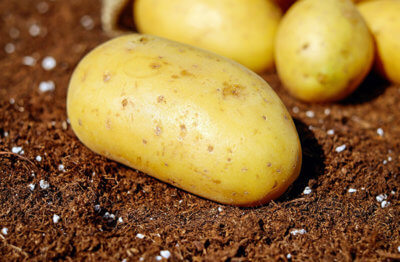Lazy (smart and responsible) gardening
Vermont gardening guru Charlie Nardozzi recently published a book called No-Dig Gardening. In its October e-newsletter, the Vermont Center for Ecostudies recommends Leaf It Be, “a low-intensity yard maintenance practice that fosters more biodiversity by providing winter homes and food sources for invertebrates, birds and other winter residents.” Translation: don’t obsess about raking! Heather McCargo, founder of the Wild Seed Project and sister of Charlotte’s Diana McCargo, proposes a no-dig method for growing potatoes that outfoxes the Colorado potato beetle.

Want to get lazy, have a productive garden, sequester carbon and support biodiversity and pollinators? Read on.
A layer of autumn leaves will provide food and shelter for pollinators and their predators (birds) and protect the ground from erosion and desiccation. Don’t abandon the rake entirely, as a deep layer of leaves can smother a lawn. Use some of the accumulated leaves for mulch (more on this in a moment); the balance can serve as a protective layer for the grass beneath it. By spring, remaining leaves will have dried up and perhaps blown away—they can often be mulched into a lawn with the first mowing. Among the insects in various life stages that overwinter in leaf litter are bumblebee queens, the pupae of Luna moths, and larval Isabella tiger moths in the form of wooly bears. Resist the urge to shred any leaves that you rake. Insect eggs, larvae and adults shelter in the leaf litter. Just pile them where you want them—a compost heap, next year’s potato patch or on your no-dig garden.
There are reasons beyond sloth to consider no-dig gardening. An intricate web of life unfolds in the soil. Fungus networks help plants to access nutrients in a symbiotic relationship with a plant’s roots. These mycorrhizae or fungi can be jeopardized by digging. By not tilling, a gardener leaves this structure intact. Mulching preserves moisture and fertility that can be lost to erosion from wind and water. The richer soil that results can sequester more carbon, reducing the amount released into the atmosphere.
Worms will turn the soil for you, creating air and water passages that support healthy plant growth. As the mulch layer decomposes, it adds organic material to the soil in a continuous process. Each year I heap up several feet of leaves, kitchen waste and grass clippings on my veggies, yet the mulch level remains constant, a few inches above the soil level. During the summer of 2020 when little rain fell, my plants, growing in water-retentive clay beneath a thick carpet of mulch, needed little or no additional water.
A few caveats: make sure to save seeds from plants that volunteer in a traditional garden. Because these seeds don’t reach the soil and germinate, volunteers that I’ve counted on for years—dill, coriander, annual poppies, arugula—did not germinate. Another point that may be intuitive: this is not a gardening style for folks who want tidiness—my garden looks fairly chaotic. But when the tomatoes fill a bucket and bright stalks of ruby chard tower above the mulch, the satisfaction of having a productive garden, with little need to weed or water, is pleasant indeed.
Potatoes in the wild
If you have a piece of ground that is rarely mowed—perhaps it’s brush-hogged once or twice a year—consider transforming a section of it into a potato patch. A parcel of mowed lawn would work as well. First, in the fall, cover the area with a thick layer of newspaper—no glossies—about six pages thick. Then cover the newspaper with leaves, lots of them, up to three or four feet deep. They will settle over the winter. If the wind barrels across your yard, anchor the leaves with a few branches. In the spring the leaves will have compressed to a thick, soggy layer. Plant potato eyes through the leaves—they will rest on the newspaper. Soon leaves will appear and roots will penetrate the rotting newspaper into the earth below. Harvesting is like an Easter egg hunt. Just reach through the leaves—likely to be dry and crumbly by mid-summer—and grab the potatoes. It’s unlikely that the Colorado potato beetle will find the potatoes, as their eggs are in the soil of the vegetable garden. Move the potato patch to another spot each year, far enough to evade the beetles. It worked for me!
Summer may be in the rearview mirror, but cyanobacteria blooms persist in Lake Champlain and other lakes across the state. Warm water, nutrients and calm days are producing blooms more frequently and later in the season than just a few years ago. Be careful with pets and anyone still swimming in late October.
Happy fall!

